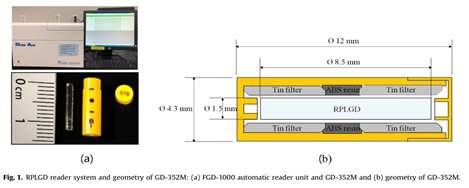글로벌 연구동향
방사선방호 및 안전
- [Nuclear Engineering and Technology] Measurement uncertainty analysis of radiophotoluminescent glass dosimeter reader system based on GD-352M for estimation of protection quantity방호량 평가를 위한 유리선량계(GD-352M) 기반 선량평가시스템의 측정불확도 분석
KIRAMS / 김재석*
- 출처
- Nuclear Engineering and Technology
- 등재일
- 2022
- 저널이슈번호
- Volume 54(2), 479-485
- 내용
-
Abstract
At the Korea Institute of Radiological and Medical Sciences, physical human phantoms were developed to evaluate various radiation protection quantities, based on the mesh-type reference computational phantoms of the International Commission on Radiological Protection. The physical human phantoms were fabricated such that a radiophotoluminescent glass dosimeter (RPLGD) with a Tin filter, namely GD-352M, could be inserted into them. A Tin filter is used to eliminate the overestimated signals in low-energy photons below 100 keV. The measurement uncertainty of the RPLGD reader system based on GD-352M should be analyzed for obtaining reliable protection quantities before using it for practical applications. Generally, the measurement uncertainty of RPLGD systems without Tin filters is analyzed for quality assurance of radiotherapy units using a high-energy photon beam. However, in this study, the measurement uncertainty of GD-352M was analyzed for evaluating the protection quantities. The measurement uncertainty factors in the RPLGD include the reference irradiation, regression curve, reproducibility, uniformity, energy dependence, and angular dependence, as described by the International Organization for Standardization (ISO). These factors were calculated using the Guide to the Expression of Uncertainty in Measurement method, applying ISO/ASTM standards 51261(2013), 51707(2015), and SS-ISO 22127(2019). The measurement uncertainties of the RPLGD reader system with a coverage factor of k = 2 were calculated to be 9.26% from 0.005 to 1 Gy and 8.16% from 1 to 10 Gy. A blind test was conducted to validate the RPLGD reader system, which demonstrated that the readout doses included blind doses of 0.1, 1, 2, and 5 Gy. Overall, the En values were considered satisfactory.
- 유리선량계 측정 시스템의 구성 및 유리선량계의 구조

- 불확도 항목에 따른 유리선량계 측정 시스템의 측정 불확도 결과
Affiliations
Jae Seok Kim ae, Byeong Ryong Park a, Jaeryong Yoo a, Wi-Ho Ha a, Seongjae Jang a, Won Il Jang a, Gyu Seok Cho b, Hyun Kim c, Insu Chang d, Yong Kyun Kim ea
National Radiation Emergency Medical Center, Korea Institute of Radiological and Medical Sciences, 75 Nowon-ro, Nowon-gu, Seoul, Republic of Korea
b
Research Team of Radiological Physics & Engineering, Korea Institute of Radiological and Medical Sciences, 75 Nowon-ro, Nowon-gu, Seoul, Republic of Korea
c
Research Center, Dongnam Institute of Radiological and Medical Sciences, 40, Jangan-eup, Gijang-gun, Busan, Republic of Korea
d
Radiation Safety Management Division, Korea Atomic Energy Research Institute, 111 Daedeok-daero 989beon-gil, Yuseong-gu, Daejeon, Republic of Korea
e
Department of Nuclear Engineering, University of Hanyang, 222 Wangsimni-ro, Seongdong-gu, Seoul, Republic of Korea
- 키워드
- Radiophotoluminescent glass dosimeter (RPLGD)GD-352MMeasurement uncertaintyDosimetric characteristics
- 연구소개
- 본 연구는 방사선 방호량 평가를 위해 유리선량계 측정 시스템의 측정 불확도를 평가한 논문입니다. 측정불확도는 측정된 방사선량의 값의 신뢰성을 나타내기 때문에 다양한 요소를 파악하여 측정 불확도를 평가를 해야합니다. 먼저, 유리선량계 측정 시스템의 불확도 항목을 선정한 후 각 항목을 평가하여 종합적인 불확도를 평가하였고 블라인드 테스트를 통해 불확도 검증을 진행하였습니다. 그 결과, 유리선량계 측정 시스템은 확장불확도(k=2)에서 0.005-1 Gy는 9.26%, 1 Gy-10 Gy는 8.16%로 평가되었다.
- 덧글달기
- 이전글 [Radiat Prot Dosimetry.] SPATIAL DISTRIBUTION ANALYSIS AND DOSE ASSESSMENT OF THE RADON EMITTED FROM THE MONAZITE-CONTAINING MATTRESS IN GENERAL RESIDENTIAL SPACE BY CFD METHODS
- 다음글 [Health Phys.] Estimation of the Thyroid Equivalent Doses to Residents in Areas Affected by the 2011 Fukushima Nuclear Disaster Due to Inhalation of 131I Based on Their Behavioral Data and the Latest Atmospheric Transport and Dispersion Model Simulation









